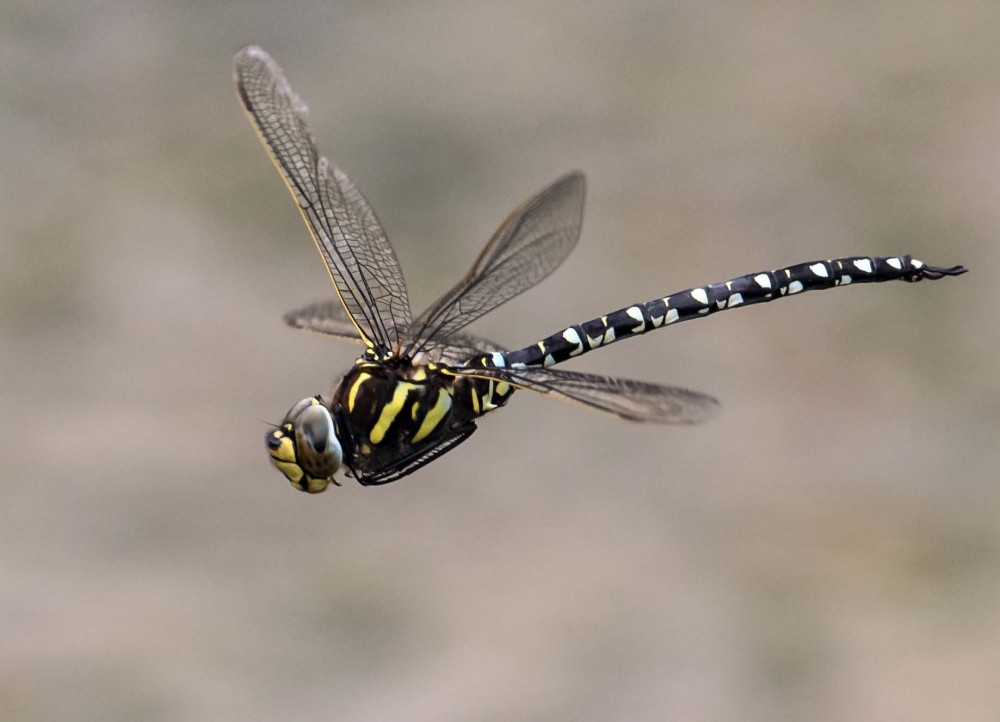Name
Aeshna juncea (Linnaeus, 1758)
Family:
Aeshnidae
Status in Britain and Ireland:
common and widespread; local in eastern England
Local Status:
local
Size:
Overall body length 65-80mm
Hindwing length 40-48mm
Flight period:
Mid June until September
Photograph © B. Kemp
Male Common Hawker
The dark abdomen is noticeably waisted and has paired blue spots and smaller yellow marks. The anal appendages are long. The thorax has 2 broad yellow side stripes(often with a splash of colour between) and narrow but prominent yellow antehumeral stripes. The wings have a yellow costa and long dark pterostigma and maybe slightly suffused yellowish brown in mature specimens. The eyes are blue with a broad contact point between the 2. The legs are mainly black though the upper part (femur) maybe brown.
Similar Species
In Shropshire most likely to be confused with Southern and Migrant Hawkers. Migrant Hawkers are unlikely to be found in the same acidic heathland habitat as Common Hawker and the males have very reduced antehumeral stripes. Migrant Hawker of both sexes also have a distinctive ‘golf- tee’ shape on segment 2 lacking in Common Hawker. Southern Hawker may be seen in similar habitat though broad antehumeral stripes and continuous bands of colour on abdominal segments 9 and 10 easily distinguish Southern Hawker. In addition the Common Hawker has a distinctive yellow costa which is brown in the Southern and Migrant Hawker.
Behaviour
A large powerful and fast hawker which rarely seems to come to a rest! Males can be seen flying low around pool side vegetation searching for females or aggressively chasing off other males. When rarely perching they prefer shrubs or tree branches to an exposed open area. Mating often lasts for an hour or more then the female oviposits alone into submerged plant material. The resulting larvae remain in the water for up to 4 years and eventual emergence usually takes place during the hours of darkness.
Habitat
Prefers still neutral- acidic waters of lakes and boggy pools, typically in areas of heathland or moorland.
Shropshire Distribution
First recorded in 1932 on Whixall Moss and then again in 1950 and 1969. A further early record was made in 1953 at Llanymynech. Records increased in the 1970s with further sightings at Whixall Moss, The Bog (Stiperstones), Soudley Pools (nr Church Stretton) and Cricket Pool near Bromfield. Throughout the 1980’s recorder effort increased and first sightings were made at Cramer Gutter on Catherton Common and a number of sites on Titterstone Clee Hill. In the 1990’s Lockton et al., (1996) described this species as local and this remains the case. Whilst distribution maps show an infilling of previously recorded areas, the specific habitat requirements of this species will limit the distribution. Interestingly the National Atlas (Cham et al., 2014) showed a significant decline on a national scale. The State of Dragonflies 2021 report has also recently shown this species is in decline though Shropshire does not seem at present to reflect this decline. State of Dragonflies 2021
Where to see in Shropshire
Whixall Moss, Wildmoor Pool and Pole Cottage Pool on the Long Mynd, Cramer Gutter on Catherton Common and The Bog at Stiperstones. Also recorded recently at Eardington Nature Reserve.




